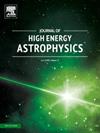Constraining the parameters of heavy dark matter and memory-burdened primordial black holes with DAMPE electron measurements
IF 10.5
4区 物理与天体物理
Q1 ASTRONOMY & ASTROPHYSICS
引用次数: 0
Abstract
The DArk Matter Particle Explorer (DAMPE) is a space-based instrument for detecting GeV-TeV cosmic rays and gamma rays. High-energy cosmic rays could be emitted from several dark matter candidates theoretically, such as the heavy dark matter (HDM) and the primordial black holes (PBHs). HDM particles with a mass of could decay into ≳10 TeV electron/positron pairs. PBHs with a mass of would survive to the present day if the Hawking radiation is significantly suppressed due to the memory burden effect and can also lead to the emission of ≳10 TeV electrons. In this work, we use the DAMPE electron measurements to obtain the constraints on the decay lifetime τ of HDM and the entropy index k of memory-burdened PBHs at 95% confidence level. The constraints on the fraction are also derived with a fixed k. Furthermore, the high-energy tail of the DAMPE electron spectrum shows a sign of going upwards, possibly suggesting the presence of an additional component; we discuss if this spectral behavior is real, which parameter space is required for it to be attributed to HDM or PBH. We will show that the required parameters have been constrained by existing limits.
用DAMPE电子测量约束重暗物质和承载记忆的原始黑洞的参数
暗物质粒子探测器(DAMPE)是一个探测 GeV-TeV 宇宙射线和伽马射线的天基仪器。从理论上讲,高能宇宙射线可能来自几种候选暗物质,如重暗物质(HDM)和原始黑洞(PBHs)。质量为100TeV的HDM粒子可以衰变成≳10TeV的电子/正电子对。如果霍金辐射由于记忆负担效应而被显著抑制,质量为≲1010g的PBH将存活至今,并且还能导致≳10TeV电子的发射。在这项工作中,我们利用DAMPE电子测量得到了HDM衰变寿命τ和记忆负担PBH熵指数k在95%置信度下的约束。此外,DAMPE 电子能谱的高能量尾部显示出向上的迹象,这可能暗示着额外成分的存在;我们将讨论这种能谱行为是否真实,以及将其归因于 HDM 或 PBH 所需的参数空间。我们将证明所需的参数已经受到现有限制的约束。
本文章由计算机程序翻译,如有差异,请以英文原文为准。
求助全文
约1分钟内获得全文
求助全文
来源期刊

Journal of High Energy Astrophysics
Earth and Planetary Sciences-Space and Planetary Science
CiteScore
9.70
自引率
5.30%
发文量
38
审稿时长
65 days
期刊介绍:
The journal welcomes manuscripts on theoretical models, simulations, and observations of highly energetic astrophysical objects both in our Galaxy and beyond. Among those, black holes at all scales, neutron stars, pulsars and their nebula, binaries, novae and supernovae, their remnants, active galaxies, and clusters are just a few examples. The journal will consider research across the whole electromagnetic spectrum, as well as research using various messengers, such as gravitational waves or neutrinos. Effects of high-energy phenomena on cosmology and star-formation, results from dedicated surveys expanding the knowledge of extreme environments, and astrophysical implications of dark matter are also welcomed topics.
 求助内容:
求助内容: 应助结果提醒方式:
应助结果提醒方式:


